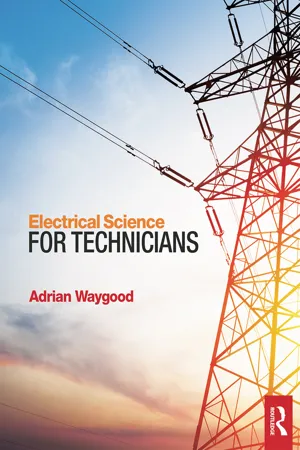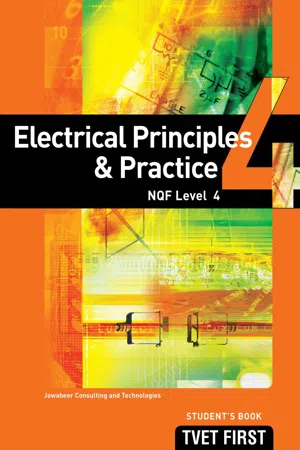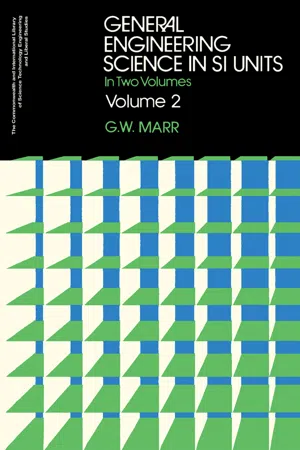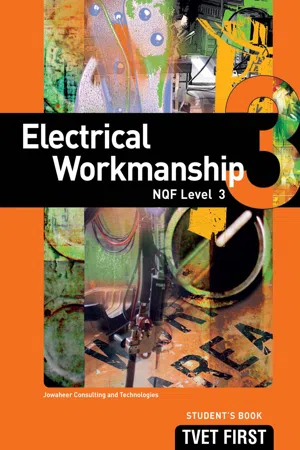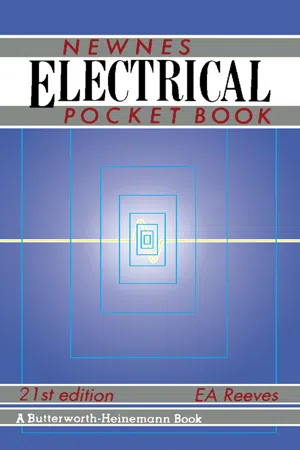Physics
Ammeter
An ammeter is a device used to measure electric current in a circuit. It is typically connected in series with the circuit, allowing it to measure the flow of current through the circuit. Ammeters are designed to have low resistance to minimize their impact on the circuit being measured, and they are essential tools for understanding and analyzing electrical systems.
Written by Perlego with AI-assistance
Related key terms
1 of 5
9 Key excerpts on "Ammeter"
- eBook - ePub
- Adrian Waygood(Author)
- 2015(Publication Date)
- CRC Press(Publisher)
General Conference of Weights and Measures was held in November 2014. The proposed new definition of the ampere will be based on the numerical value of the elementary charge (i.e. the amount of charge on a single electron), a figure yet to be agreed! So, as far as the ampere is concerned, watch this space!Measuring current, voltage, and resistance
Although we are able to observe the effects of an electric current or voltage, we cannot, of course, ‘see’ the actual current or voltage itself. So, in order to detect and to measure these quantities, together with resistance, we need instruments that will do the ‘seeing’ and ‘measuring’ for us. The three basic instruments used for this purpose are the Ammeter, voltmeter and ohmmeter (Figures 7.2 , 7.3 and 7.4 ):Most of us are very unlikely to use these individual instruments outside a college laboratory. We are far more likely to use a multimeter (Figure 7.5 ), either analogue or digital, which combines the functions of these three separate instruments into one .Figure 7.5In this chapter, though, we’ll first consider the separate functions of a multimeter. We’ll start by learning how analogue instruments work and how to use them, as they are significantly more complicated to prepare and use. If we can handle an analogue instrument, then we will have no difficulty transferring these skills to a digital instrument.Analogue instruments
Measuring current
Before connecting an Ammeter into a circuit, we must always start by de-energizing that circuit with its load-breaking device, such as a circuit breaker.To measure current, we must disconnect the circuit at the point where we wish to measure that current and, then, insert the Ammeter at that point. In other words, an Ammeter must be connected in series with the circuit under test, as illustrated in Figure 7.6 (where R - eBook - PDF
- Dale R. Patrick, Stephen W. Fardo, Ray E. Richardson, Brian W. Fardo(Authors)
- 2020(Publication Date)
- River Publishers(Publisher)
Electrical measurement plays a very important role in the operation and evaluation of building equipment. Electrical instruments that are used to perform the measurement function are either energized by the system being test-ed or by an independent source of electric-ity. Voltmeters, Ammeters, wattmeters, and kilowatt hour meters derive their opera-tional energy from the system under test. Specialized instruments that employ ac-tive components such as transistors vacu-um tubes or digital displays must also be energized by an independent electrical source in order to function. Electrical instruments are designed primarily to measure specif-ic electrical values and display this information in a usable manner. Hand-defection meters digital display instruments, and chart record-ing instruments may be used to perform the measurement function. These instruments may be designed to measure only one specific electrical quantity over a rather narrow range or several different quantities with multiple ranges. Typical electrical quantities that are Figure 10-23. (a) Flex-ible-tube manometer; (b) portable roll-up manom-eter. ( Courtesy of Dwyer Instruments Inc. ) 384 Energy Conservation Guidebook measured in the evaluation of building equipment are voltage, cur-rent, power, resistance, and power factor. The measurement of certain electrical quantities often causes some confusion because of the terminology used. Current, for exam-ple, is measured with an Ammeter. The fundamental unit of current is the ampere (A). Voltmeters are used to measure electrical voltage. The fundamental measuring unit of voltage is the volt (V). Electrical power is somewhat unusual because it is measured in watts (W). Wat-thours (Wh) are a measure of the power consumed for a given unit of time. Resistance is measured with an ohmmeter. Meters of this type may have the word “ohms” or the Greek letter omega ( Ω ) displayed on the scale. - eBook - PDF
Electricity and Electronics for Renewable Energy Technology
An Introduction
- Ahmad Hemami(Author)
- 2017(Publication Date)
- CRC Press(Publisher)
A multimeter is a multipurpose device that can measure current in addition to voltage and resistance. It has the capability to measure additional entities, such as capacitance and frequency. In circuit schematics a circle with a letter “A” in it represents an Ammeter, as shown in Figure 5.1. Similarly, a circle with a letter “V” in it represents a voltmeter, which measures voltage. Note that all the com-ponents (including the source) and wires in a single circuit (one loop only) have the same current. In Chapter 6 we will discuss multiloop circuits. Because in DC electricity current has one direction and in AC electric-ity current direction constantly changes, measuring current in AC and DC is not done by the same Ammeter. For DC a DC meter must be used. In multimeters switching from AC meter to DC and from current to voltage and so on can be done using a selector switch with which one selects the desired choice. In measuring DC current the red lead of the meter must be connected to the positive side and the black lead to the negative side. If the leads are switched, the reading will be negative. (The needle is forced to Ammeter: Device to measure electric current. Multimeter: Device for electrical measure-ments with selectable switches to function as voltmeter, ohmmeter, and Ammeter, and some more capabilities (all in the same unit). To measure current in a circuit, an Ammeter must be inserted inside the circuit. The circuit must be opened for this purpose. R Load = 100 Ω 120 V 0.5 Ω A Open the circuit at any point 0.5 Ω Figure 5.1 Step 1 for measuring the current in a circuit. Voltage, Current, and Power 87 turn to left in an analog device.) In some Ammeters (not multimeters) with a needle the zero point is in the middle and the motion of the needle indi-cates both positive and negative readings. This is helpful for the circuits in which current can be either positive or negative. - Russell Smith(Author)
- 2018(Publication Date)
- Cengage Learning EMEA(Publisher)
This func-tion generally protects the ohm function from voltage overloads. Other digital meters are protected by fuses that have to be changed for the meter to again function. Several digital meters are shown in Figure 4.10 . Make sure electrical test equipment is in good condition. Digital meters © Cengage ® FIGURE 4.10 Delmar Online Training Simulation Electricity for HVAC Copyright 2019 Cengage Learning. All Rights Reserved. May not be copied, scanned, or duplicated, in whole or in part. Due to electronic rights, some third party content may be suppressed from the eBook and/or eChapter(s). Editorial review has deemed that any suppressed content does not materially affect the overall learning experience. Cengage Learning reserves the right to remove additional content at any time if subsequent rights restrictions require it. 64 CHAPTER 4 Electric Meters 4.2 AmmeterS The Ammeter uses the basic meter movement discussed in Section 4.1. The strength of the magnetic field determines the distance that the nee-dle of the meter moves. Figure 4.11(a) shows the magnetic field and the meter movement when there is a high current flow through the conductor. Figure 4.11(b) shows the magnetic field and the meter movement when there is a low current flow in the conductor. The larger the current flow, the stronger the magnetic field grows and the greater the needle move-ment on the scale. The Ammeter measures current flow in an electric circuit. There are basically two types of Ammeters used in the industry today: the clamp-on Ammeter and the in-line Ammeter. The clamp-on Ammeter is the most popular because it is the easiest to use. You simply clamp the jaws of the meter around one conductor feeding power to the load that is producing the current draw. The analog clamp-on Ammeter is shown in Figure 4.12 . Figure 4.13 shows several digital clamp-on Ammeters.- eBook - PDF
Electrical Principles & Practice NQF4 SB
TVET FIRST
- Jowaheer Consulting and Technologies(Author)
- 2014(Publication Date)
- Macmillan(Publisher)
The resistance of the milliAmmeter is 1 Ω. Determine: (a) the value of resistance measured (b) the true value of resistance (c) the percentage relative error. Summary • A voltmeter is an instrument that is used to measure the potential difference or voltage between two points in a circuit. A voltmeter must be connected across the load in parallel. • An Ammeter is an instrument that is used to measure the value of current in an electrical circuit. An Ammeter must be connected in series with the circuit. • An ohmmeter is an instrument that is used to measure electrical resistance. An ohmmeter is connected in parallel in a circuit. • A wattmeter is an instrument that measures DC or AC power in a circuit. There are two types of wattmeters: electrodynamic wattmeters and dynamometers. • A frequency meter is used to measure the number of cycles per second. • An insulation tester is used to test the insulation resistance of an installation or appliance. • A clamp-on Ammeter is a type of Ammeter. It is also referred to as a tong tester. • An instrument transformer enables a small measuring instrument to measure high voltage and high current. This prevents heavy loads flowing through to instrument panels. The use of instrument transformers results in increased safety, convenience and accuracy. There are two types of instrument transformers: current transformers and potential transformers. • A current transformer (CT) is used in electricity meters to make it easier to measure large currents. A CT is designed to provide a current in its secondary winding. This current is proportional to the current flowing in its primary winding. • A potential transformer (PT) is a step-down transformer that is used with a low-range voltmeter to measure voltages in excess of 500 V safely. The primary winding is connected across the high voltage supply and the secondary winding is connected to the voltmeter. - eBook - PDF
General Engineering Science in SI Units
In Two Volumes
- G. W. Marr, N. Hiller(Authors)
- 2016(Publication Date)
- Pergamon(Publisher)
Section 10 Ammeters and Voltmeters 10.1. Introduction Ammeters and voltmeters are instruments used to measure electric currents and potential differences respectively. The names of the instruments derive from the basic units in which these electrical quantities are normally measured (Ammeter being an abbreviated form of ampere-meter). In this section, only two types of these instruments are considered. These are the permanent-magnet moving-coil type and the moving-iron type of instrument. 10.2. Permanent-magnet Moving-coil (P.M.M.C.) Instrument This type of instrument depends for its operation on the force exerted on a current-carrying conductor when the conductor lies in a magnetic field. A coil of fine insulated wire is pivoted between jewelled bearings so that it can rotate in the magnetic field of a permanent magnet. The coil is usually wound on a light aluminium frame or former to which the small stub axles are also attached (Fig. 10.1). Coil rotation is controlled by spiral springs made either of phosphor bronze or beryllium copper strip. One end of a spring is attached to each axle and the other end of each spring is anchored to the main support frame. These springs are also used to lead current to and from the coil. 197 GENERAL ENGINEERING SCIENCE IN SI UNITS In earlier forms of P.M.M.C. instruments, the permanent magnet was either horse-shoe or U-shaped and relatively large. Modern magnetic materials such as Alcomax make it possible to produce equally effective magnets with a much smaller volume of material, so that present designs are more compact. Some of these materials are difficult to machine and the magnet is of a simple shape as shown diagrammatically in Fig. 10.2. The remainder of the mag-Pointer Winding Balance weights ^Former .Rear spiral spring (front spring not shown) FIG. 10.1. netic circuits is made from mild steel machined to shape. - eBook - ePub
- Ahmad Hemami(Author)
- 2017(Publication Date)
- CRC Press(Publisher)
Change in the voltage is relatively small, and it does not affect the resistance of the element. Thus, the new current is130 ÷ 55 = 2.36 ΩExample 5.5 When a lightbulb is connected to 120 V supply, it lights up and the current is 0.5 A. If the applied voltage is 220 V instead, what is the current?SolutionAlthough for this problem one can numerically find a value for the new current, because the voltage is almost doubled, the physical lightbulb cannot withstand the higher current and its filament will blow.5.5 Measuring Electric CurrentAny electric circuit has a current in it based on the components in the circuit and based on the voltage of its source. Often, it is necessary to measure the current in a circuit for diagnosing problems and repairs. For measuring current we use an Ammeter , a device directly graduated in amps and decimal fractions of amp. To measure current in a circuit, an Ammeter must be inserted inside the circuit; that is, it must become part of the loop forming the circuit. Figure 5.1 shows that for measuring the current in a circuit you need to open the circuit at one (appropriate) point. Then you connect the two leads of the meter to the open ends of the circuit. In this way the Ammeter integrates to the loop and becomes part of the circuit. See Figure 5.2 .Ammeter: Device to measure electric current.To measure current in a circuit, an Ammeter must be inserted inside the circuit. The circuit must be opened for this purpose.For measuring current one can use an Ammeter, which measures the electric current only, or use a multimeter . A multimeter is a multipurpose device that can measure current in addition to voltage and resistance. It has the capability to measure additional entities, such as capacitance and frequency. In circuit schematics a circle with a letter “A” in it represents an Ammeter, as shown in Figure 5.1 . Similarly, a circle with a letter “V” in it represents a voltmeter, which measures voltage. Note that all the components (including the source) and wires in a single circuit (one loop only) have the same current. In Chapter 6 - eBook - PDF
Electrical Workmanship NQF3 SB
TVET FIRST
- Jowaheer Consulting and Technologies(Author)
- 2013(Publication Date)
- Macmillan(Publisher)
The internal circuitry of a digital meter is made up of integrated circuits. Various models are available and digital meters are more popular now than analogue meters. Figure 2.4 illustrates a digital multimeter. Table 2.1 compares analogue and digital meters. Table 2.1: A comparison of analogue and digital meters Analogue meter Digital meter • Has moving parts including a pointer • Error due to parallax is possible • Takes measurement by reading the correct scale • Auto range setting not possible • Requires frequent calibration • No moving parts • No parallax error • Value given on display is measured value • Auto ranging instruments are available • Requires recalibration at least once a year Handheld instruments In this section we will discuss the following handheld instruments: • Ammeter • voltmeter • ohmmeter • multimeter • tachometer • stroboscope • insulation resistance tester • voltage tester • earth leakage / polarity tester • clamp-on meter. Ammeter An Ammeter is used to measure the value of the current in an electrical circuit. The Ammeter must be part of the circuit to be measured. You must therefore connect an Ammeter in series so that it can measure all the current through the circuit. The Ammeter thus has a very low resistance. To connect an Ammeter, ensure that the circuit is open and insert the Ammeter. Figure 2.5 shows the symbol for an Ammeter and Figure 2.6 shows the connection in series of an Ammeter. Voltmeter A voltmeter is used to measure the potential difference between two points in an electric circuit. To measure voltage, connect the probes of the voltmeter across the load in There is no point in using a good meter if a careless reading gives an inaccurate measurement. In the workplace Note Be careful when handling digital meters as they contain digital circuitry that may be damaged by careless handling. - eBook - PDF
- E A Reeves(Author)
- 2013(Publication Date)
- Newnes(Publisher)
18 Instruments and meters Most instruments and meters are based on either the magnetic principle or that of electro-magnetic induction. Some of these meters like phase angle, wattmeter, frequency meter and VAr meter use an electronic converter and a moving coil indicator rather than a direct induction effect. This should be remembered when reading the appropriate sections. In addition there are a number of other instruments which make use of electrostatic, heating and chemical effects, each of these having a special application or applications. AmmeterS AND VOLTMETERS The normal instruments for measuring current and voltage are esentially the same in principle, as in most cases the deflection is proportional to the current passing through the instrument. These meters are, therefore, all Ammeters, but in the case of a voltmeter the addition of a series resistance can make the reading prop-ortional to the voltage across the terminals. Types are: 1. Moving iron (suitable for a.c. and some suitable for d.c.) 2. Permanent magnet moving coil (suitable for d.c. only). 3a. Air cored dynamometers - moving coil (suitable for a.c. and d.c.) particularly used for high-precision measurements. 3b. Iron cored dynamometers - moving coil (generally only suitable for a.c.) particularly used for high-precision measurements. 4. Electrostatic (for a.c. and d.c. voltmeters). 5. Induction (suitable for a.c. only). 6. Hot wire (suitable for a.c. and d.c). All these instruments measure rms values except the moving coil which measures average values. Therefore when measuring rectified and/or thyristor-controlled supplies it is important to 463 know whether the load current for example as registered is the rms or average value. Heating or power loads generally require rms indication while battery charging and electrochemical proces-ses depend on average values. Although some of the above square law instruments will read d.c.
Index pages curate the most relevant extracts from our library of academic textbooks. They’ve been created using an in-house natural language model (NLM), each adding context and meaning to key research topics.
